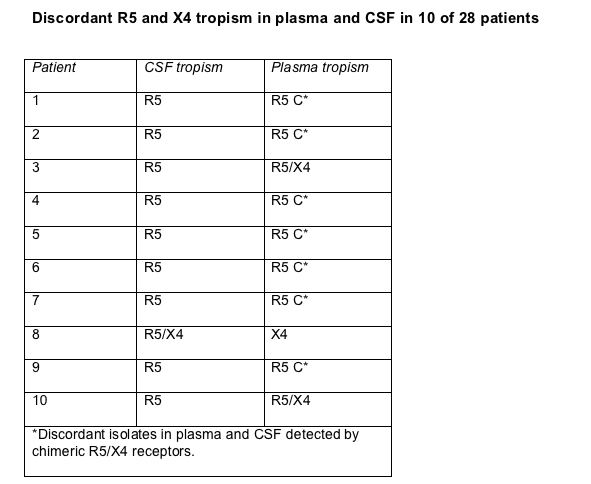 |
 |
 |
| |
HIV May Like Different Coreceptors in Blood and Brain
|
| |
| |
46th ICAAC, September 27-30, 2006, San Francisco
Mark Mascolini
September 27, 2006
HIV circulating in blood and cerebrospinal fluid (CSF) showed evidence of homing to different cellular coreceptors in 10 of 28 people (36%) studied at Lund University in Sweden [1]. The findings raise questions about separate HIV evolution in the brain and how CCR5 antagonists--now in late stages of testing--may affect that evolution.
Earlier these researchers engineered a set of chimeric receptors that combine parts of the CCR5 receptor and the CXCR4 receptor [2]. HIV that uses CCR5 ("R5-tropic" virus) typically predominates early in the course of infection. In later stages of infection HIV that prefers CXCR4 ("X4-tropic" virus) predominates in some people.
With colleagues from Sahlgrenska Academy in Goteborg, the Lund team analyzed paired plasma and CSF virus sampled from 28 HIV-infected people at different stages of infection. They used virus stocks to infect cell lines transfected with CD4 and either CCR5, CXCR4, or their R5/X4 chimeras.
R5-tropic virus predominated in both plasma and CSF. But there were exceptions. Plasma HIV isolates from 7 people used X4 either alone (in 1 person) or with R5 (in 6). Four of these 7 people had only R5-tropic virus in CSF. Six of 21 people who had exclusive R5-tropic virus in plasma and CSF had major differences in chimeric coreceptor use. Thus, all told, 10 of 28 people had evidence of discordant coreceptor tropism in plasma and CSF (Table).
Discordant R5 and X4 tropism in plasma and CSF in 10 of 28 patients

The ability of plasma R5 virus to use the R5/X4 chimeric receptor labeled FC-2 strongly correlated with greater CD4 deficits but did not correlate significantly with higher viral load. Nine people with FC-2 use and exclusive R5 isolates in plasma had a median CD4 count of 49 versus 495 CD4s in 12 people with FC-2-negative virus (P = 0.004). As earlier studies show, X4 virus or mixed R5/X4 virus signaled advanced CD4 depletion (median 60 cells, P = 0.005 versus the FC-2-negative group).
The researchers suggest that evolution of different coreceptor tropism in blood and CSF "most likely reflects more efficient [viral] replication in abundant target [CSF] cells," such as macrophages and microglial cells. They conclude that "discordance of viral phenotype in plasma and CSF is frequent and needs to be considered in the context of emergent treatment" with CCR5 antagonists.
References
1. Karlsson UJ, Antonsson L, Owman C, et al. Coreceptor use in paired plasma and cerebrospinal fluid HIV-1 isolates. 46th ICAAC. September 27-30, 2006, San Francisco. Abstract H-246.
2. Karlsson I, Antonsson L, Shi Y, et al. HIV biological variability unveiled: frequent isolations and chimeric receptors reveal unprecedented variation of coreceptor use. AIDS 2003;17:2561-2569.
|
| |
|
 |
 |
|
|